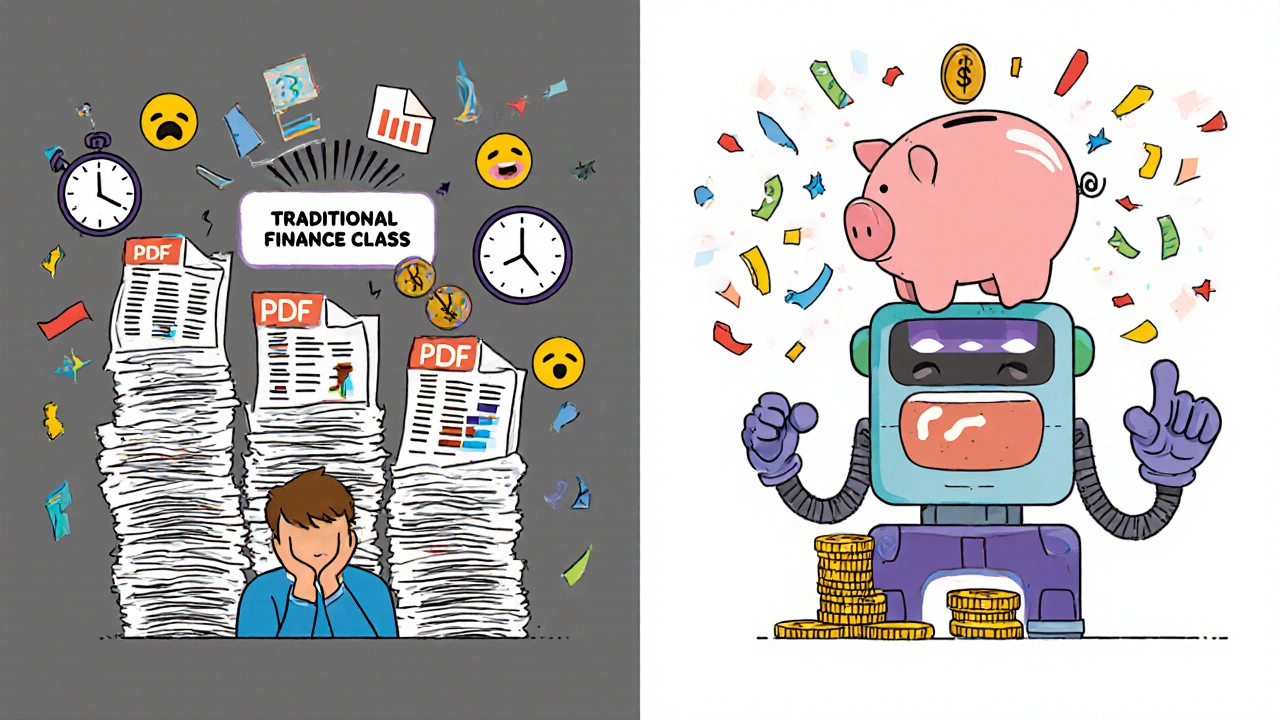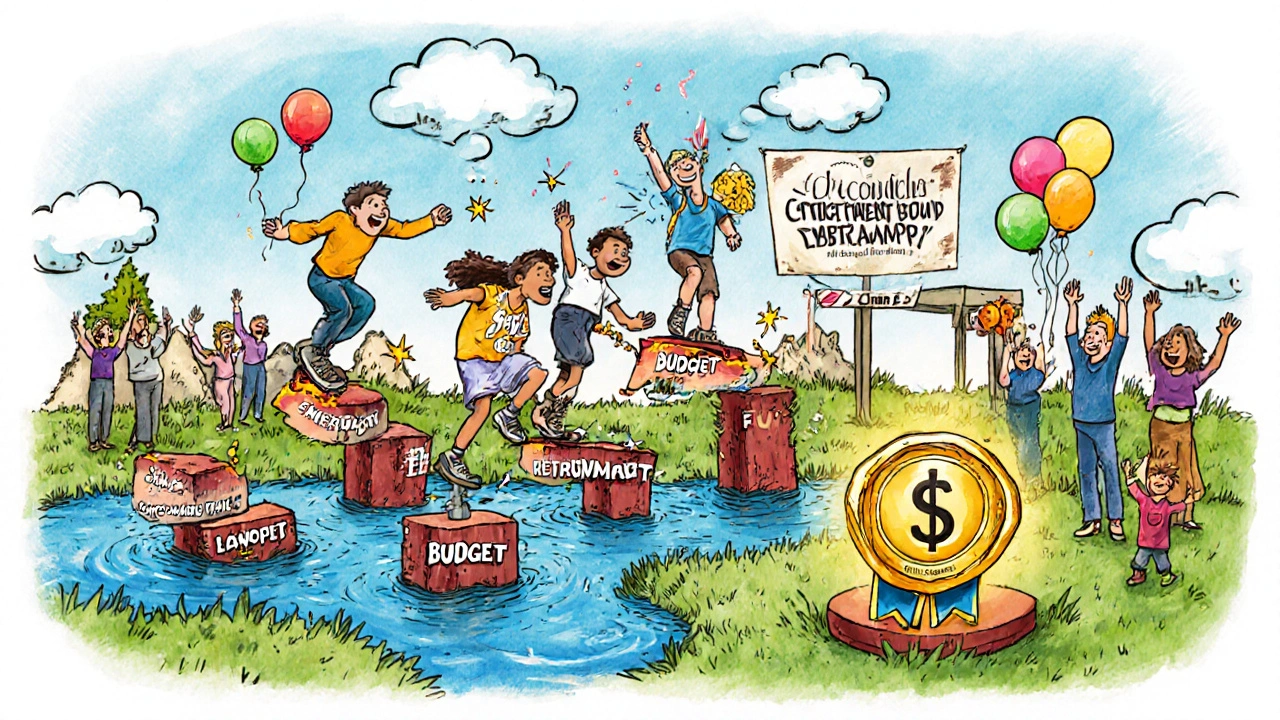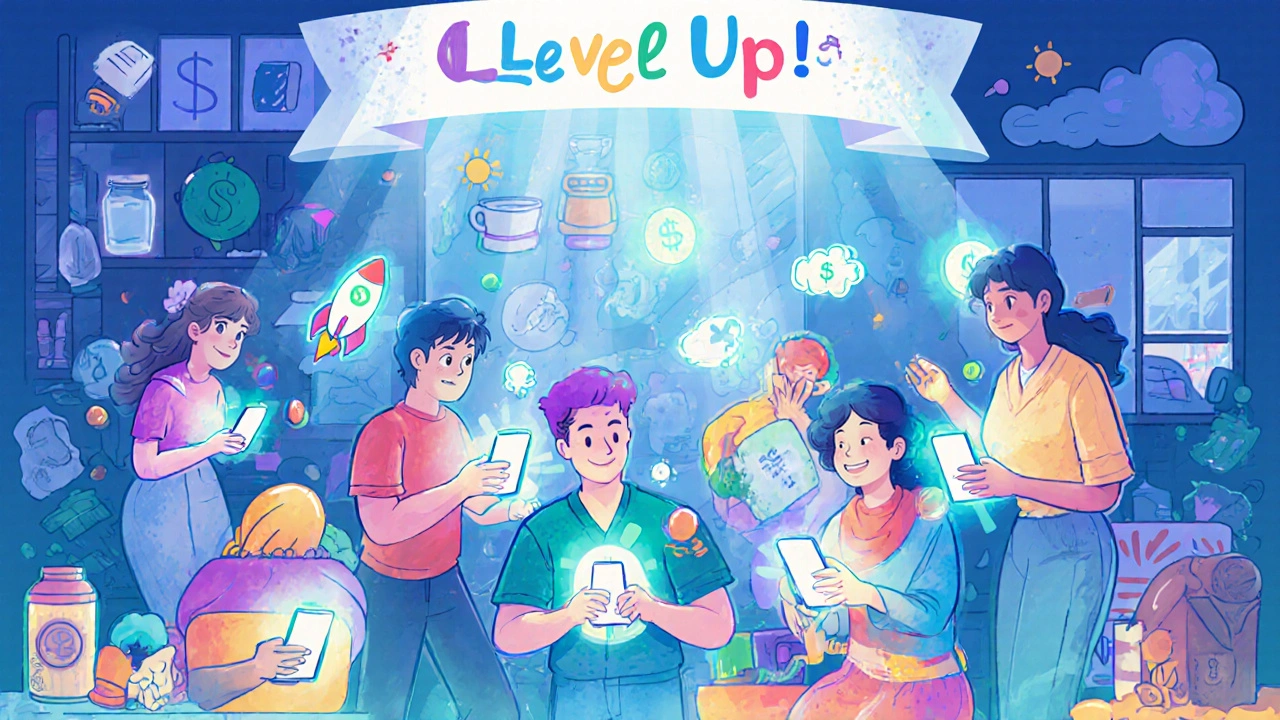Daily Financial Challenge Calculator
Turn Small Habits into Big Savings
How much can you save by making small changes to your daily spending? This calculator shows how small financial habits add up over time with gamified progress tracking.
Your Financial Journey
Gamified ProgressDaily Impact
$5.00 saved daily
$150.00 total saved in 30 days
Next Milestone
$50.00 more to reach $200 milestone
Your Progress
Financial Tip
By saving $5 daily, you'll have $182.50 after 365 days with 2.5% interest. That's enough for a small vacation or emergency fund boost!
Why Financial Education Feels So Boring (And How to Fix It)
Most people know they should save more, budget better, and plan for retirement. But when they try to learn how, they’re handed a 50-page PDF or forced to sit through a two-hour webinar that feels like watching paint dry. Why? Because traditional financial education treats money like a math problem - not a human one.
Here’s the truth: people don’t fail at money because they’re bad at math. They fail because they’re overwhelmed, anxious, or just plain bored. A 2017 study by The Boston Fed found that only 25-30% of people who attend financial workshops remember what they learned a month later. And even fewer change their behavior.
Enter gamification. Not as a gimmick. Not as a way to make finance "cute." But as a proven, science-backed way to turn financial learning from a chore into something people actually want to do.
How Gamification Actually Works (It’s Not Just Points and Badges)
Gamification in financial education isn’t about turning your budget into a video game. It’s about using what psychology and behavioral economics already know works: motivation, feedback, progress, and social connection.
Take the Commonwealth financial education platform. Instead of telling users to "save $100 this month," it gives them a challenge: "You start with 100 points. If you skip your coffee run three times this week, you earn 20 points. Miss your savings goal? You lose 15. Reach 40 points in a week? You level up."
This isn’t random. It’s based on loss aversion - the idea that people feel the pain of losing something more than the joy of gaining it. Starting with points you can lose makes people more careful. It’s not about winning. It’s about not losing.
Other proven mechanics include:
- Progress bars that show how close you are to your emergency fund goal
- Leaderboards that let you compare progress with friends (not to compete, but to feel accountable)
- Daily missions like "Track every expense today" or "Review your credit score"
- Unlockable content - like a video on how to negotiate a raise - after completing a series of tasks
A 2024 study in Jurnal Pengurusan tracked 98 people using these techniques. After just 8 weeks, their financial literacy scores jumped by 43.4%. Their confidence to make financial decisions rose by 32.8%. And most importantly, their actual financial behavior - like paying bills on time or avoiding high-interest debt - improved significantly (p < 0.001).
Why Gamification Beats Traditional Classes
Traditional financial education is lecture-based. Gamified learning is experience-based.
In a classroom, you hear: "Compound interest is powerful." In a gamified app, you see: "If you save $50 a month starting at 25, you’ll have $187,000 by 65. If you wait until 35? Just $82,000. Want to see what happens if you save $75 instead? Try it."
The difference? One is abstract. The other is interactive.
Here’s the data:
| Metric | Gamified Approach | Traditional Workshop |
|---|---|---|
| Engagement Rate | 87.3% | 25-30% |
| Financial Literacy Improvement | +43.4% | +8-12% |
| Behavior Change After 3 Months | 71% | 19% |
| Average Time to Competency | 3.2 hours | 7.8 hours |
| User Satisfaction Rating | 4.6/5 | 2.9/5 |
And it’s not just students. A 2023 study from the University of San Francisco found that low-income workers using gamified tools improved their digital financial skills by 39%. That’s not just knowing what a 401(k) is - it’s actually using the app to check balances, set alerts, and adjust contributions.

Real Apps That Are Getting It Right
You don’t have to imagine this. It’s already happening.
- Mint (acquired by Intuit in 2009) was one of the first to use gamified budgeting. It didn’t just show spending categories - it gave you weekly "budget wins" and color-coded your progress like a game.
- Current, a banking app for teens and young adults, uses "missions" - small, daily financial tasks like "Deposit $5 into savings" - that unlock rewards like free ATM fee refunds.
- Commonwealth’s Prize-Linked Savings lets users earn entries into a monthly cash prize every time they save. It’s like a lottery, but you win by saving - not spending.
- Thammasat University in Bangkok used gamified tools with first-jobbers. Those who used the app were 68% more likely to start retirement savings than peers who attended traditional seminars.
And the results are clear. On App Store reviews, gamified financial apps average 4.6 stars. 83% of users say they feel more confident managing money. On Trustpilot, 76% of users say the rewards system is what keeps them coming back.
The Catch: Gamification Isn’t Magic
Here’s what no one tells you: gamification can backfire if it’s done poorly.
Some apps turn financial goals into meaningless point-chasing. You earn badges for logging in every day - but never learn how to read a pay stub or understand interest rates. That’s not education. That’s distraction.
Research from the USFCA thesis (2023) found that when games lack real financial content, improvements in numeracy and knowledge don’t show up. You might feel motivated - but you still don’t know how to calculate your debt-to-income ratio.
And then there’s the "novelty effect." 29-35% of users stop using the app after a few months. Why? The challenges get repetitive. The rewards feel cheap. The leaderboard becomes a source of stress, not motivation.
The fix? Constant updates. Personalization. Real-world feedback.
Commonwealth’s 2025 update uses AI to adjust challenges based on your spending habits. If you keep overspending on groceries, it doesn’t just say "cut back." It says: "You spent $180 on groceries last week. Try this: meal prep on Sunday. You’ll save $45 and earn 30 points."
That’s the difference between a game and a coach.

Who Benefits Most?
Gamification doesn’t work for everyone - but it works wonders for groups traditionally left behind by financial education.
- Gen Z and millennials: 79% and 68% respectively use gamified tools. They grew up with apps, not brochures.
- Low-income families: The stress of money makes abstract advice useless. Gamification gives them immediate, tangible feedback.
- Retirees: Employers are now adding gamified retirement planners to benefits packages. 42% of Fortune 500 companies use them in 2024 - up from 18% in 2020.
- Non-native English speakers: Visual progress bars and icons transcend language barriers better than dense financial jargon.
At the same time, older adults and those with low digital literacy still struggle. The key isn’t to force them into apps - it’s to design simpler, phone-based versions. Commonwealth’s system works on basic smartphones. No app download needed. Just text-based challenges.
The Future: Where Gamification Is Headed
The global market for financial gamification hit $1.87 billion in 2023. It’s on track to hit $5.23 billion by 2028.
What’s next?
- Open banking integration: Apps will connect to your real bank accounts and give real-time feedback. "You spent $120 on dining out this week. That’s 20% over your budget. Want to try a $10 meal prep challenge?"
- Hybrid coaching: 82% of experts predict gamified tools will be paired with live financial counselors by 2027. The app handles motivation. The human handles complexity.
- Regulation: The Consumer Financial Protection Bureau issued non-binding guidelines in 2024 to stop manipulative design - like pushing users to take on debt to earn points.
The goal isn’t to turn everyone into a gamer. It’s to turn everyone into a confident money manager.
How to Start Using Gamification Today
You don’t need to build an app. You can start right now:
- Download a free app like Current, Mint, or YNAB (You Need A Budget). Look for features labeled "challenges," "missions," or "goals."
- Set one small, daily task: "Track every expense today." Complete it for 7 days straight. You’ll feel momentum.
- Find a friend to join you. Share your progress. No leaderboards. Just accountability.
- Don’t chase points. Chase behavior. If you’re saving $20 more a week, that’s the win - not the badge.
- If an app feels like a chore, switch. There are dozens. Find the one that feels like a game, not a task.
The best financial education doesn’t feel like education. It feels like play. And that’s exactly why it works.
Is gamification in financial education actually effective?
Yes. Multiple studies show it works. A 2024 study with 98 participants found financial literacy scores increased by 43.4%, and financial behavior improved significantly (p < 0.001). Users also reported 32.8% higher motivation. Unlike traditional classes, gamified learning leads to real changes in how people handle money - not just what they know.
Do I need to download an app to use gamified financial education?
No. While apps like Mint and Current are popular, some programs work through text messages or simple web tools. Commonwealth’s system, for example, lets users participate via SMS without downloading anything. The key is the design - not the platform.
Can gamification help me save for retirement?
Absolutely. Companies like Fidelity and Prudential now use gamified retirement planners for employees. Users earn points for increasing their 401(k) contributions, completing educational modules, or meeting savings milestones. One study showed employees using these tools were 68% more likely to start retirement savings than those who only attended seminars.
Is gamification just for young people?
No. While Gen Z and millennials use it most, gamification works for all ages. Older adults benefit from visual progress bars and simple feedback. Low-income families find it easier to engage with than complex financial jargon. The key is adapting the design - not the audience.
What’s the biggest mistake people make with gamified finance tools?
Chasing points instead of changing behavior. Some apps reward you for logging in daily - but don’t teach you how to read a bank statement or calculate interest. True financial literacy comes from combining game mechanics with real financial knowledge. Look for tools that explain why a task matters, not just what you earn for doing it.
Are gamified financial apps safe to use?
Most are, but check for security features. Reputable apps use bank-level encryption and don’t require you to link your account unless you choose to. The Consumer Financial Protection Bureau advises avoiding apps that push you to take on debt to earn rewards. Stick to well-known platforms like Mint, Current, or those offered by your bank or employer.

Comments (3)
Astha Mishra
It's fascinating how gamification taps into the very architecture of human motivation-loss aversion, incremental progress, social accountability-all things we’ve known since Aristotle, yet financial institutions still treat money like a spreadsheet rather than a lived experience. I’ve watched my younger cousins in Delhi go from avoiding budgets entirely to checking their savings goals daily, not because they were lectured, but because they got a little digital flower for every week they didn’t touch their emergency fund. It’s not about points-it’s about making the invisible visible. The mind craves patterns, and when your financial health becomes a story you can see unfolding, you stop seeing it as punishment and start seeing it as cultivation. And honestly? The fact that it works for non-native speakers and low-literacy populations proves this isn’t a tech fad-it’s a linguistic and cognitive breakthrough. We’ve been trying to teach finance like it’s calculus, when really, it’s poetry.
Kenny McMiller
Look, the data’s solid-43.4% literacy bump, 71% behavior change, p < 0.001. But let’s not romanticize this. Gamification works because it bypasses executive function and hooks into dopamine loops. It’s behavioral engineering, not education. The real win isn’t that people learned to budget-it’s that they got addicted to the feedback loop. That’s why retention drops after 3 months: novelty fades, and now you’ve got a population conditioned to expect rewards for basic financial hygiene. We’re not creating financially literate adults-we’re creating app-dependent automatons who think paying a bill on time is a ‘mission.’ And don’t get me started on the ‘prize-linked savings’ nonsense. That’s just a lottery with a tax write-off veneer. The real solution? Mandatory personal finance in high school. Not apps. Not badges. Just teach the damn math.
Dave McPherson
Oh wow. Another ‘gamification is the future’ thinkpiece. How original. You know what’s more effective than a mobile app with a progress bar? A parent sitting their kid down at age 12 and saying, ‘Here’s your allowance. You get $20. You want a new game? Save for 3 weeks. Want to blow it on candy? Go ahead. I’m not your bank.’ Real-world consequences. Real stakes. No notifications. No badges. No ‘unlockable content’ about how compound interest works-because if you can’t grasp that without a game, you shouldn’t be allowed to touch a credit card. This whole trend is just Silicon Valley’s way of outsourcing parenting and financial literacy to a UI designer who thinks a confetti animation counts as pedagogy. Congrats, you turned money into Candy Crush. Now the next generation won’t know how to read a bank statement unless there’s a ‘Level Up’ button.